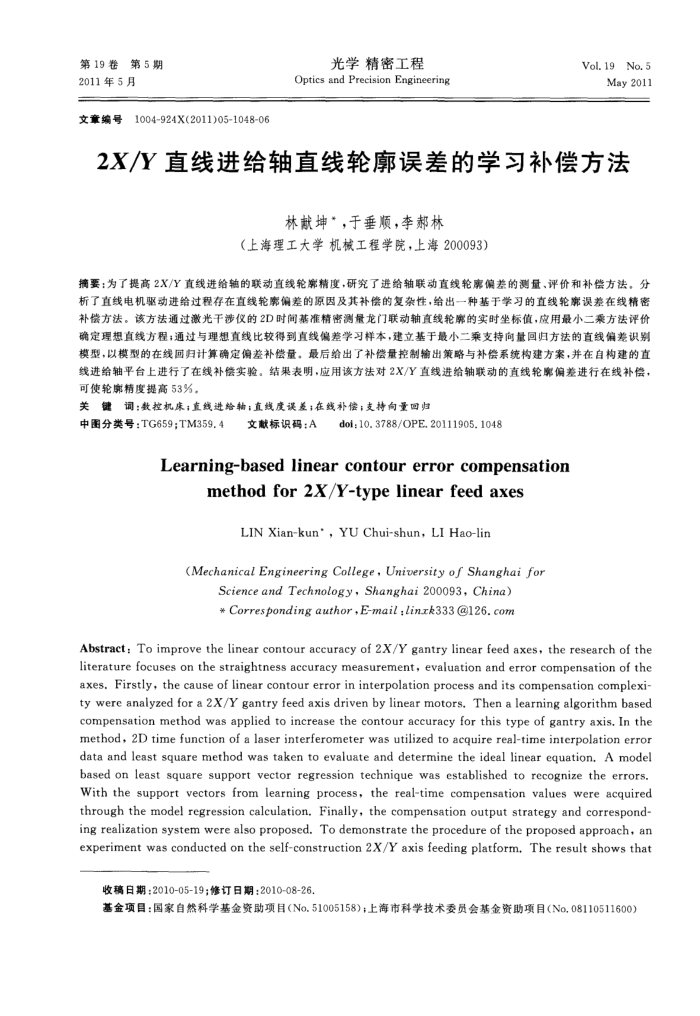您当前的位置:首页>论文资料>Y直线进给轴直线轮廓误差的学习补偿方法
Y直线进给轴直线轮廓误差的学习补偿方法
内容简介
 第19卷
第19卷第5期
2011年5月
文章编号
1004-924X(2011)05-1048-06
光学精密工程
Optics and Precision Engineering
Vol.19No.5
May 2011
2X/Y直线进给轴直线轮廓误差的学习补偿方法
林献坤*,于垂顺,李郝林
(上海理工大学机械工程学院,上海200093)
摘要:为了提高2X/Y直线进给轴的联动直线轮席精度,研究了进给轴联动直线轮库偏差的测量、评价和补偿方法。分析了直线电机驱动进给过程存在直线轮席偏差的原因及其补偿的复杂性,给出一种基于学习的直线轮廊误差在线精密补偿方法。该方法通过激光干涉仪的2D时间基准精密测量龙门联动轴直线轮席的实时坐标值,应用最小二乘方法评价确定理想直线方程;通过与理想直线比较得到直线偏差学习样本,建立基于最小二乘支持向量回归方法的直线偏差识别
线进给轴平台上进行了在线补偿实验。结果表明,应用该方法对2X/Y直线进给轴联动的直线轮率偏差进行在线补偿,可使轮廊精度提高53%,
关键词:数控机床;直线进给轴;直线度误差;在线补偿;支持向量回归
中图分类号:TG659;TM359.4
文献标识码:A
doi;10.3788/OPE.20111905.1048
Learning-based linear contour error compensation
method for 2X/Y-type linear feed axes
LIN Xian-kun', YU Chui-shun, LI Hao-lin
(Mechanical Engineering College,University of Shanghai for
Science and Technology,Shanghai 200093,China) +Correspondingauthor,E-mail;linzk333@126.com
Abstract: To improve the linear contour accuracy of 2X/Y gantry linear feed axes, the research of the literature focuses on the straightness accuracy measurement, evaluation and error compensation of the axes. Firstly, the cause of linear contour error in interpolation process and its compensation complexi-ty were analyzed for a 2X/Y gantry feed axis driven by linear motors. Then a learning algorithm based compensation method was applied to increase the contour accuracy for this type of gantry axis. In the method, 2D time function of a laser interferometer was utilized to acquire real-time interpolation error data and least square method was taken to evaluate and determine the ideal linear equation. A model based on least square support vector regression technique was established to recognize the errors. With the support vectors from learning process, the real-time compensation values were acquired through the model regression calculation. Finally, the compensation output strategy and correspond-ing realization system were also proposed.To demonstrate the procedure of the proposed approach, an experiment was conducted on the self-construction 2X/Y axis feeding platform, The result shows that
收稿日期:2010-05-19;修订日期:2010-08-26
基金项目:国家自然科学基金资助项目(No.51005158);上海市科学技术委员会基金资助项目(No,08110511600)